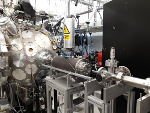| Version 8 (modified by , 4 years ago) ( diff ) |
|---|
LhARA ionacoustic dose profiling meeting: 18Aug21; 09:00 BST
Notes
JM 29/09/2021
Present: Ben Cox, Emma Harris, Ken Long, John Matheson, Colin Whyte
Discussion: KL described using an analytical approximation (Batfield 1997) to model the energy deposited by 15MeV protons in water and calculate the Bragg peak dimensions. Taking the speed of sound to be 1481 m/s then the time taken for a sound wave to travel the PFWHM is 50ns ( characteristic frequency 20MHz). BC commented that this fits with photoacoustic experiments in which the pulse length is near 10ns to ensure stress confinement. Compared to likely test beams, LhARA aims at 10-40ns bunch length, AVO uses 5-10ns bunches in a train, CERN or cylclotrons would be longer.
EH brought up potential problems with energy deposited in the material of the cuvettes holding the cell culture, leading to energy loss and generation of unwanted acoustic signals. It may be necessary to have a special cuvette or well plate design. BC noted that breast imaging may provide an example of how to do this.
A discussion was held about what the transducer (or transducer array) might look like. Transducers are 1mm – 20 mm in size typically, with bigger being more sensitive but also more directional (less good for imaging). A good approach could be to start with a single fairly large transducer on axis. Different transducers could be compared and an array could be synthesized by mechanical motion. Shaped transducers are available which have a distinct focal length. BC comments that we have to try this empirically – historically, simulations have reproduced the frequency spectrum OK but there has been significant difference between predicted and measured amplitude. EH suggested also looking at passive cavitation detectors.
In terms of costs an individual transducer is order £100. Readout is expensive – Verasonics (https://verasonics.com/about-verasonics/) do a 256 channel system for circa £110K. It was agreed that we should bid to buy one of these for LhARA as it will save on effort and add credibility. The system is essentially a rack of digitisers.
We may also be able to request funding (£10K - £205K) for equipment from https://www.ukri.org/opportunity/early-technology-development-and-equipment-for-stfc-grant-holders/ Closing date 27th Oct.
Actions:
- KL – continue simulations, how to visualise HT’s results and see where to put the transducers
- BC and EH - work on specifying the acoustic detectors
- EH – send info. on passive cavitation detectors, get quotes for acoustic kit
Agenda
- Introduction, notes and actions of previous meeting: KL/All
- KL – circulate long version of GC proposal
- Done.
- JG – circulate literature on existing lab ion acoustic imaging setups
- Done.
- KL, BC meet to discuss putting the parts of the simulation together to get the acoustic pressure for the low energy beam
- Done.
- JM, KL meet at RAL to discuss taking forward the SmartPhantom. JM talk to Liam Cooper, Fergus Wilson.
- Done.
- JB to connect KL with Emma Harris and prepare some slides for next week if possible
- Done.
- KL – circulate long version of GC proposal
- Time to traverse Bragg peak and characteristic frequency: KL
Slides.
- Proposal planning : JB, JM, All
- Next steps--discussion: All
- AOB: All
Attachments (1)
- 2021-09-28-AccFreq-KL-1.pptx (168.9 KB ) - added by 4 years ago.
Download all attachments as: .zip
